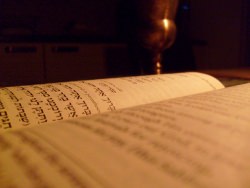 Last week, on 22 September, Yom Kippur was celebrated in the Jewish tradition. The holiest day in the Jewish calender, Yom Kippur is the day of atonement. We bring you this blog from a Catholic Canberra writer who had a privileged visit to a Synagogue as part of an interfaith excursion.
Last week, on 22 September, Yom Kippur was celebrated in the Jewish tradition. The holiest day in the Jewish calender, Yom Kippur is the day of atonement. We bring you this blog from a Catholic Canberra writer who had a privileged visit to a Synagogue as part of an interfaith excursion.
Carefully frosted on the glass are the words: ‘I have set God always before me’.
There's a beautiful curtain underneath whose colours dance joyfully, hinting at what's behind them; when drawn to the side, a collection of scrolls are revealed.
Artworks and names adorn the surrounding walls; there's the stories of creation, complete with special appearances from Galahs and Indigenous sacred spaces, and symbols representing festivals.
Ten slender wooden panels standing in solidarity and perfectly engraved in Hebrew complete the circle.
Two candles on the altar are lit and so begins a joyful immersion into the Jewish ritual, Shabbat, which celebrates the commencement of the Sabbath, the seventh day; a day of rest and abstinence of work in remembrance of God's creation.
Looking through the lens of ‘the other’ I was instantly moved by the warm welcome offered by the progressive Jewish community at North Shore Temple Emmanuel in Sydney.
I (quietly) applauded the sense of inclusion and equity created - a male and a female rabbi, sitting in a circle with their companions and guests, sharing in prayer and afterwards, kiddish.
I admired the proud sense of identity expressed by our Jewish brothers and sisters, who we share the roots of our faith with. I felt the rhythm and soulfulness echo in the chants and readings and movements.
A faith tradition I assumed was about observance and one which had got it wrong changed quite dramatically within an hour.
We are all capable of holding prejudices and I did. Perhaps I’d held onto this from my first encounter with an observant Jew, who when I asked rather naively over the College dinner table - trying rather anxiously to spark conversation among strangers: ‘so what's everyone doing at Christmas?’
He had retorted rather strongly, ‘I'm Jewish. Jesus isn't the Messiah. We don't celebrate it’.
I recall a long, silent pause as I swallowed my ignorance. I wasn’t prepared to question further and my dinner compatriot wasn’t prepared to elaborate either. We sat there. Awkwardly.
By dipping my toe in again some ten years later, I’ve come to understand the complimentary vision we all hold - to try and put God before us.
I wondered: how might ‘the other’ view us, as Tykes? How do we welcome our faithful counterparts into our sacred spaces and traditions? How might we draw on the shared past to continue moving interfaith relations forward? How might our Church progress?
Religious Historian, Karen Armstrong, has called on the global society to revive the Golden Rule by putting aside obtuse doctrinal differences and focusing on living out compassion, which she argues - and many would agree - is central to or at the heart of all faiths.
Armstrong asserts that in order to pass on a viable world to future generations, it is imperative we cultivate compassion through dignity, respect and equity.
And it starts here with you and me. Just as the hymn ‘Let There be Peace on Earth’ mandates, ‘let it begin with me’, so I need to begin and continue learning about, and appreciating our multi-faith world in order to realise God's vision: ‘shalom’.
Helen Jacobs is a Religious Education teacher, and is currently doing a course studying other religions.
Photo: Kiddush at home